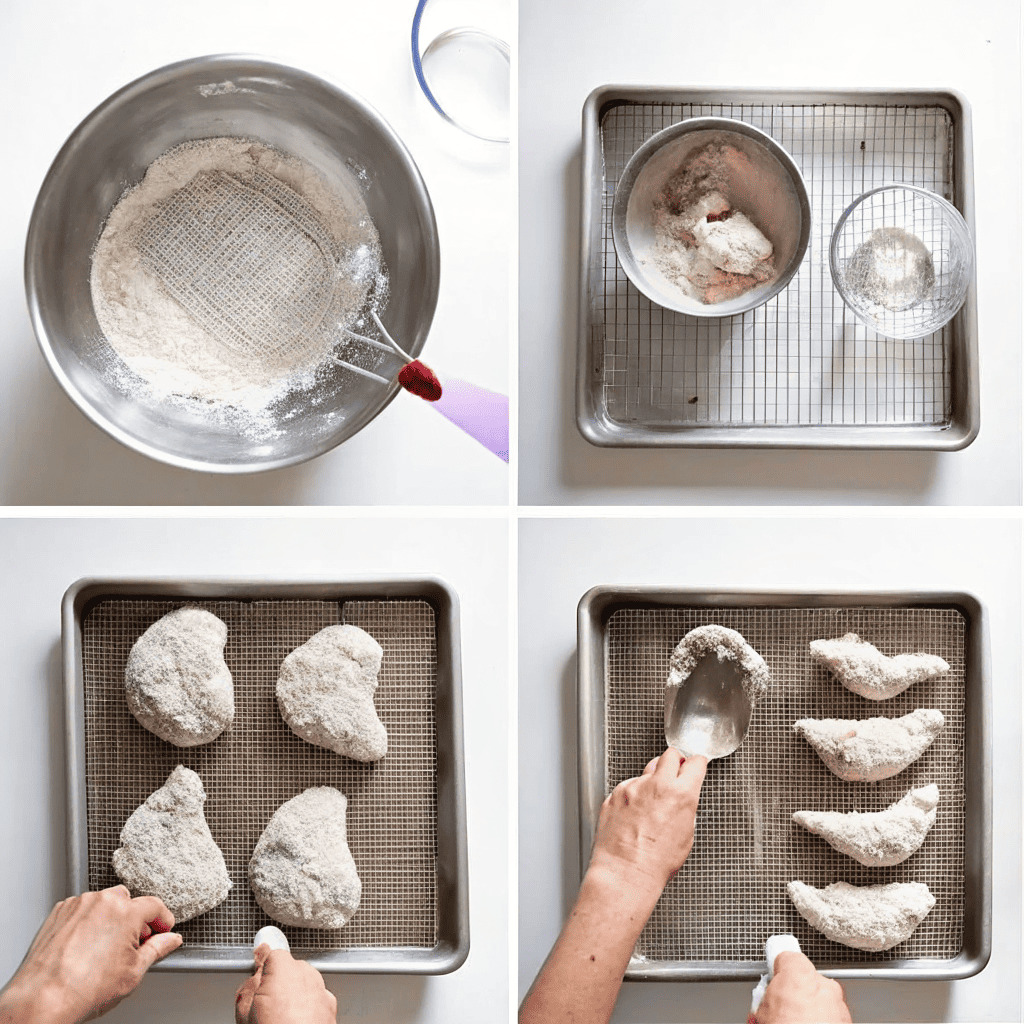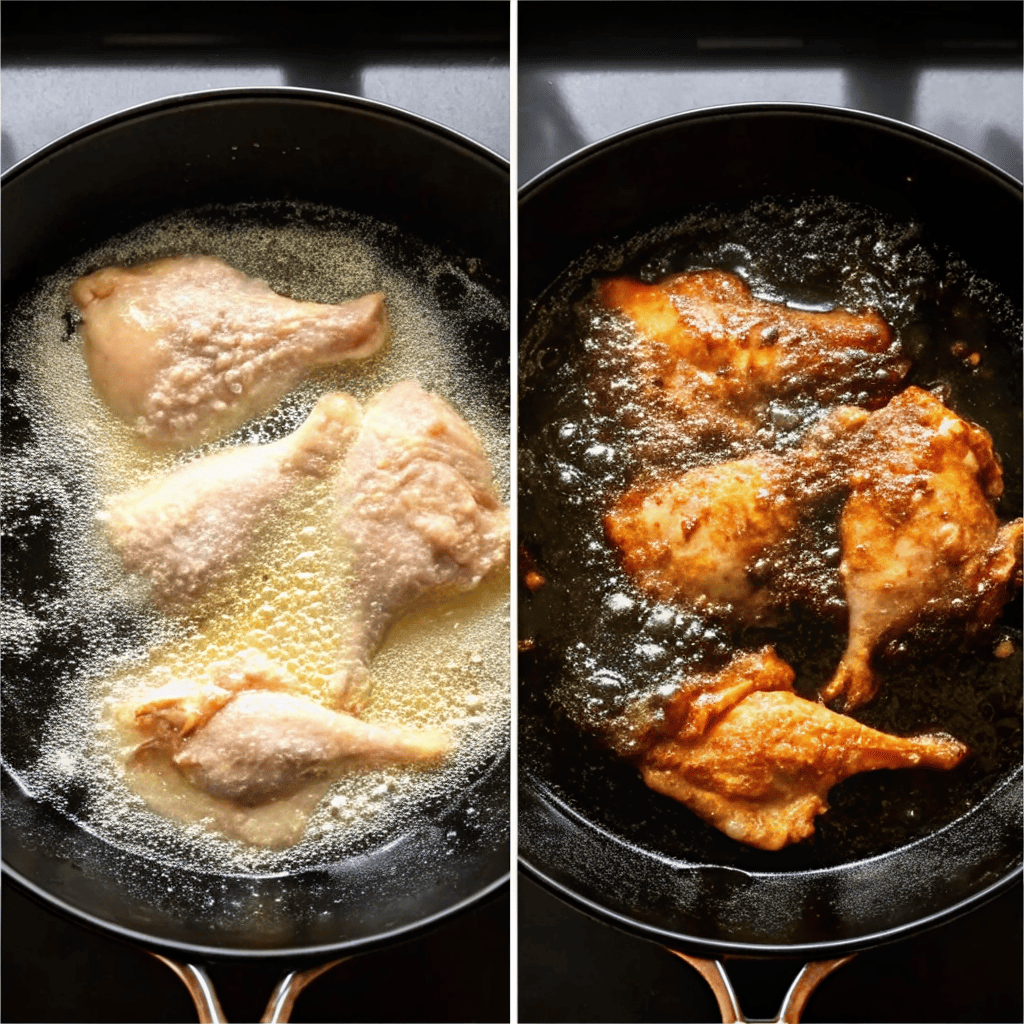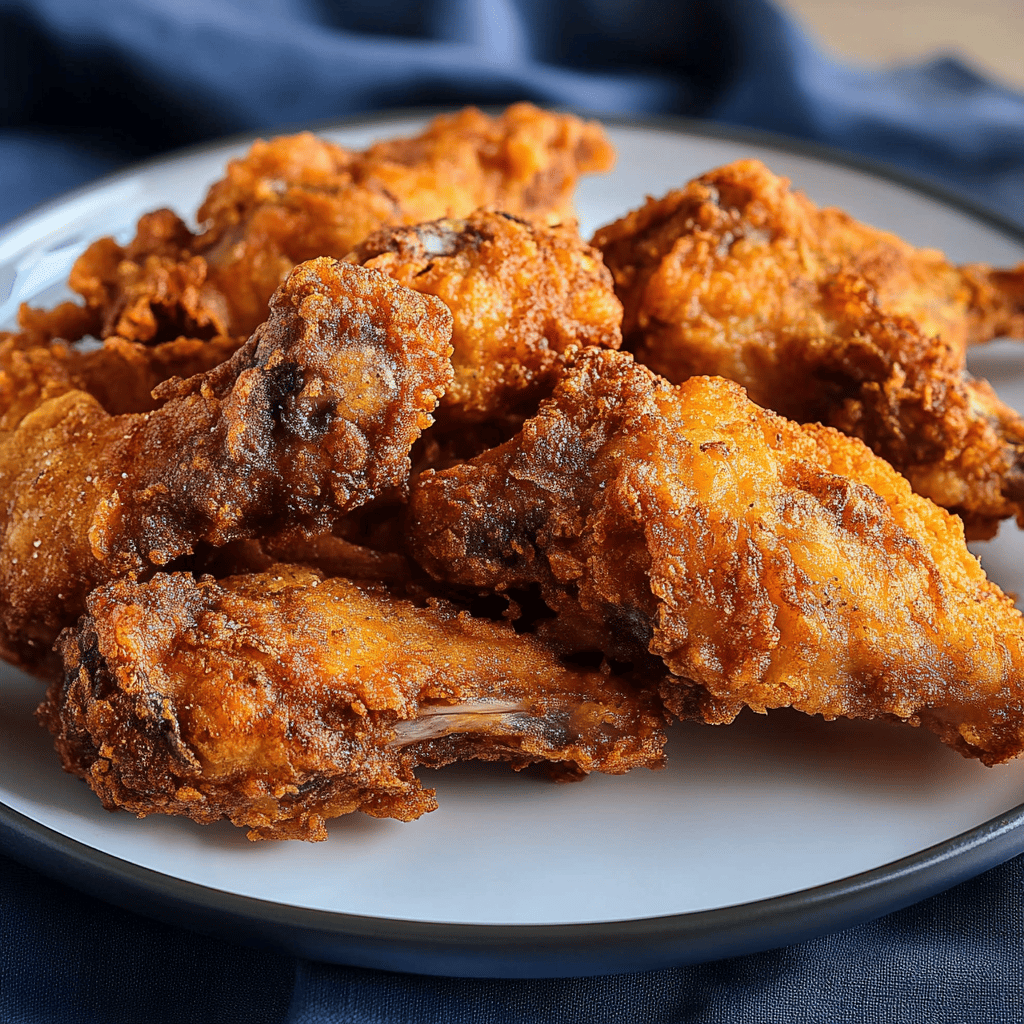Southern Fried Rabbit: A Taste of Tradition from Skillet to Table
I was just a kid the first time I watched my grandmother brine a rabbit in her old yellow bowl. We didn’t call it “farm-to-table” back then—it was just dinner. My grandfather would come in from the woods with a fresh catch, and she’d go right to work, pouring in buttermilk, herbs, and spices until the air smelled like something was about to happen. That rabbit would soak all day, and come suppertime, she’d drop each flour-dusted piece into a cast iron skillet, where it sizzled and crisped to the color of autumn leaves.
This Southern fried rabbit recipe is more than a method—it’s memory on a plate. It’s for anyone who’s ever stood barefoot on a kitchen stool, sneaking tastes of flour dredge while waiting for the oil to heat. The buttermilk brine makes the meat tender and flavorful, the crust crackles just right, and the whole dish speaks to a simpler kind of cooking—one rooted in love, seasonality, and using what the land gives you. If you’re ready to try rabbit the right way, you’re in the right place.
Preparing Southern Fried Rabbit, Step by Step
Table of Contents

Delicious Deep Fried Rabbit Recipe for Home Cooking
- Total Time: 8 hrs 50 mins
- Yield: 4 servings 1x
Description
Southern fried rabbit made the traditional way with a rich buttermilk brine and a crisp, golden flour dredge. A true comfort food recipe that honors Southern heritage and backyard cooking.
Ingredients
To Brine the Rabbit:
-
3 cups (710 ml) buttermilk
-
2 teaspoons (8 g) Diamond Crystal kosher salt
-
1/2 teaspoon mustard powder
-
1/2 teaspoon paprika
-
1/4 teaspoon freshly ground black pepper
-
1/4 teaspoon garlic powder
-
1/4 teaspoon onion powder
-
8 sprigs fresh thyme, picked
-
2 sprigs fresh rosemary, picked and chopped
-
1 (3-pound; 1.4 kg) rabbit, broken down into 6 pieces
To Dredge and Fry:
-
2 cups (260 g) all-purpose flour
-
1 tablespoon (12 g) Diamond Crystal kosher salt
-
1/2 teaspoon freshly ground black pepper
-
4 cups (1 L) neutral oil, such as vegetable oil
Instructions
-
In a large bowl, whisk together buttermilk, salt, mustard powder, paprika, pepper, garlic powder, onion powder, thyme, and rosemary.
-
Add rabbit pieces, coat well, and transfer to a zip-top bag. Refrigerate 8–12 hours, flipping occasionally.
-
Remove rabbit from brine and let excess drip off.
-
In a bowl, mix flour, salt, and pepper. Dredge rabbit in flour, pressing firmly.
-
Set dredged rabbit on a wire rack and let rest 15 minutes.
-
Preheat oven to 200°F (95°C). Line a baking sheet with a rack and another with paper towels.
-
Heat oil in a 12-inch cast iron skillet to 350°F (175°C).
-
Fry rabbit in batches, 8–10 minutes per side, until golden and internal temp reaches 160°F (70°C).
-
Transfer to rack and keep warm in the oven.
-
Skim oil and repeat with remaining rabbit. Let rest 5 minutes before serving.
Notes
-
Brine overnight for the juiciest results.
-
Use a thermometer to keep frying temperature steady.
-
Letting the dredged rabbit rest before frying helps the crust stay on.
-
Serve with collard greens, cornbread, or charcuterie nachos for a hearty spread.
- Prep Time: 8 hrs 30 mins
- Cook Time: 20 mins
- Category: Main
- Method: Frying
- Cuisine: Southern
Nutrition
- Serving Size: 1.5 pieces
- Calories: 420
- Sugar: 1g
- Sodium: 780mg
- Fat: 18g
- Saturated Fat: 3g
- Unsaturated Fat: 13g
- Trans Fat: 0g
- Carbohydrates: 22g
- Fiber: 1g
- Protein: 45
- Cholesterol: 125mg
Keywords: Southern fried rabbit, buttermilk fried rabbit, deep fried rabbit
Preparing Southern Fried Rabbit, Step by Step
Brining for Moisture and Flavor

The secret to tender, flavorful Southern fried rabbit lies in the brine. With a little patience and a few pantry staples, you’ll turn this lean meat into something deeply satisfying. Start with 3 cups of buttermilk—it tenderizes the rabbit and lets the seasoning work its way into every bite. Mix in 2 teaspoons of kosher salt, a half teaspoon each of mustard powder and paprika, and a dash of garlic and onion powders. Fresh rosemary and thyme finish the job, giving your Southern fried rabbit a rustic, herbal backbone.
Break down a 3-pound rabbit into six pieces—front legs, hindquarters, and saddle—and soak them in that buttermilk mixture for at least 8 hours, or up to 12. Place everything in a large freezer bag, refrigerate, and flip the bag once or twice to keep the rabbit evenly coated. While that brine does its job, why not prep something special on the side? A bold starter like blood tongue sausage or a few bites from our wild turkey recipes pair beautifully with the rustic feel of Southern fried rabbit.

Flour Dredging Tips for Maximum Crisp
When the brining’s done, it’s time to get that crust just right. Preheat your oven to 200°F and set a wire rack over a baking sheet. In a mixing bowl, combine 2 cups of all-purpose flour, 1 tablespoon kosher salt, and some cracked pepper. That’s your dredge—and where the outside of your Southern fried rabbit gets its seasoned crunch.
Take one piece at a time from the brine, let the excess drip off, and dredge it in the flour mix. Press firmly to help the coating stick. Let the coated pieces rest for 15 minutes while you heat up 4 cups of neutral oil to 350°F. Fry the rabbit in batches, about 8–10 minutes per side, until golden and cooked through. Keep the first batch warm in the oven while you finish the rest.
Let your Southern fried rabbit rest five minutes before serving—it keeps the juices inside and the crust crispy. It goes great with a side of venison cowboy butter or a rustic starter like butter board appetizers. This isn’t just dinner—it’s a Southern kitchen tradition reborn.
Frying and Serving Southern Fried Rabbit with Style

Golden Frying Techniques You Can Count On
Frying Southern fried rabbit isn’t complicated, but a few small details make all the difference between greasy and golden. First, always use a deep, heavy skillet—cast iron is perfect. Heat 4 cups of neutral oil to 350°F, and don’t rush it. Too cool, and your coating gets soggy. Too hot, and you’ll burn the outside before the inside is cooked. A kitchen thermometer is your best friend here.
Work in batches—two or three pieces at a time. Don’t crowd the skillet, or the oil temp will drop fast. Let the first side cook for 8–10 minutes until it’s a deep golden brown, then flip and fry the other side for about 7 minutes more. You’re aiming for 160°F at the thickest part of the meat. As each piece finishes, move it to a wire rack over a paper towel-lined sheet pan and pop it in a 200°F oven to stay warm while you finish the rest.
Skim the oil between batches to remove any loose flour bits. Clean oil means clean flavor. And don’t forget to rest the rabbit five minutes before serving. That’s how you lock in the juices without steaming the crust.
What to Serve with Southern Fried Rabbit
The crispy, savory richness of Southern fried rabbit pairs beautifully with Southern staples and modern crowd-pleasers. Try it next to a spread of charcuterie nachos for a fun twist, or balance the deep-fried flavor with something lighter like pickled okra or a vinegar-based slaw.
If you’re leaning more traditional, think about fresh cornbread, mashed potatoes, or creamy grits. This dish also shines when served with seasonal vegetables or something bold like venison backstrap marinade as a second protein for a hearty table.
And don’t forget the drinks. Sweet tea is a classic, but hard cider or a dry rosé cuts through the richness just right. However you serve it, Southern fried rabbit brings a sense of tradition, effort, and satisfaction that’s hard to beat.
Tips, Troubleshooting, and FAQs About Southern Fried Rabbit
Avoiding Toughness and Common Mistakes
When folks say “rabbit’s too tough”, it usually means something went wrong in the prep—not the protein. The key to tender, flavorful Southern fried rabbit is time. A long buttermilk soak—at least 8 hours—is non-negotiable. Skip it, and you’re left with meat that’s dry and chewy.
The second biggest mistake? High frying temps or rushing the cook. Rabbit is lean, and it can dry out fast. Use a thermometer and maintain 350°F in the skillet. Flip gently, and don’t overcook. Letting the fried rabbit rest for five minutes before serving also gives juices time to settle. This helps keep every bite moist, not stringy.
One more tip: always let the dredged rabbit rest before frying. That 15-minute pause lets the flour bind to the buttermilk layer, creating a crust that clings and crisps. If your coating slides off in the oil, chances are it went in too soon or the flour wasn’t packed on firmly enough.
FAQs About Southern Fried Rabbit
Is fried rabbit tough?
Not if it’s done right. Rabbit becomes tough when it’s overcooked or not properly brined. The buttermilk brine in this Southern fried rabbit recipe helps break down the muscle fibers, making the meat juicy and tender. Stick to the recommended times and temperatures, and it’ll be just right—crispy outside, tender inside.
How do you tenderize rabbit before frying?
The easiest way is a long soak in buttermilk seasoned with salt, herbs, and spices. Brining for 8 to 12 hours tenderizes the meat naturally while adding rich, savory flavor. It’s the same method used for fried chicken, but it works even better for rabbit.
How does fried rabbit taste?
Fried rabbit tastes like chicken with character. It’s leaner, a little sweeter, and slightly earthy—but not gamey. The crispy crust from the seasoned flour adds crunch and seasoning, while the buttermilk brine keeps the meat juicy. For folks who enjoy dishes like venison backstrap recipes, it’s a perfect addition to the rotation.
Why do you soak rabbits before cooking?
Soaking in buttermilk does two things—it tenderizes and seasons. The acids in buttermilk break down proteins in the rabbit, making it more tender. The herbs and spices in the brine infuse the meat with flavor. Without soaking, Southern fried rabbit risks being bland and dry.
Conclusion
Southern fried rabbit isn’t just a recipe—it’s a story told through cast iron and buttermilk. It’s the kind of meal that makes you slow down, gather your people, and cook with purpose. The crispy crust, the herby brine, the golden-brown bite that’s both rustic and refined—this dish brings a bit of old tradition back to the modern table.
Whether you’re a seasoned hunter or a home cook ready to try something new, this Southern fried rabbit will win you over one bite at a time. Serve it with confidence, knowing you’re honoring time-tested cooking and putting something special on the table. And if this recipe inspired you, explore more wild and flavorful dishes like venison cowboy butter or charcuterie nachos next.
📌 Follow along or tag me here:
Facebook: Recipes NYC on Facebook
Pinterest: @Recipes_NYC on Pinterest
Medium: https://medium.com/@recipesnyc

